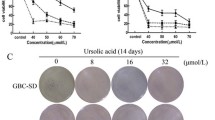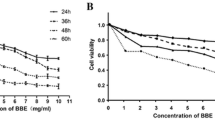Abstract
In the present study, effects of aqueous extracts from Crocodylus siamensis bile (AE-CB) on SMMC-7721 cell growth, cell cycle, and apoptosis were investigated by 3-(4,5-dimethylthiazol-2-yl)-2,5-diphenyl tetrazolium bromide assay, inverted microscopy, fluorescence microscopy, propidium iodide (PI) single- and fluorescein isothiocyanate (FITC)/PI double-staining flow cytometry, and western blotting. Our data have revealed that AE-CB significantly inhibited the growth of SMMC-7721 cell and arrested cell cycle at G0/G1 phase. SMMC-7721 cells showed typical apoptotic morphological changes after treated with AE-CB for 48 h. Cell death assay indicated that SMMC-7721 cells underwent apoptosis in a dose-dependent manner induced by AE-CB. In addition, AE-CB treatment could downregulate the protein level of Bcl-2 and upregulate the Bax, leading to the increase in the ratio of Bax to Bcl-2 in SMMC-7721 cells. Meanwhile, it was observed that the expression of Survivin and c-Myc decreased, but the expression of P53 increased. All these events were associated with increase of reactive oxygen species. The data indicated that mitochondrial pathway might play an important role in bile extract-induced apoptosis in SMMC-7721 cells. These results provide significant insight into the anticarcinogenic action of bile extract on SMMC-7721 cells.






Similar content being viewed by others
Abbreviations
- ROS:
-
Reactive oxygen species
- PI:
-
Propidium iodide
- FBS:
-
Fetal bovine serum
- MTT:
-
3-(4,5-Dimethylthiazol-2-yl)-2,5-diphenyl tetrazolium bromide
- HRP:
-
Horseradish peroxidase
- ECL:
-
Enhanced chemiluminescence
References
Boatright, J. H., Nickerson, J. M., Moring, A. G., & Pardue, M. T. (2009). Journal of Ocular Biology, Diseases, and Informatics, 2, 149–159.
Chakraborty, S., Ghosh, U., Bhattacharyya, N. P., Bhattacharya, R. K., & Roy, M. (2006). Mutation Research, 596, 81–90.
Di Toro, R., Campana, G., Murari, G., & Spampinato, S. (2000). European Journal of Pharmaceutical Sciences, 11, 291–298.
Fang, Y., Han, S. I., Mitchell, C., Gupta, S., Studer, E., Grant, S., et al. (2004). Hepatology, 40, 961–971.
Feng, Y., Siu, K., Wang, N., Ng, K. M., Tsao, S. W., Nagamatsu, T., et al. (2009). Journal of Ethnobiology and Ethnomedicine, 5, 2.
Fimognari, C., Lenzi, M., Cantelli-Forti, G., & Hrelia, P. (2009). Annals of the New York Academy of Sciences, 1171, 264–269.
Horowitz, N. S., Hua, J., Powell, M. A., Gibb, R. K., Mutch, D. G., & Herzog, T. J. (2007). Gynecologic Oncology, 107, 344–349.
Hu, H., Ahn, N. S., Yang, X., Lee, Y. S., & Kang, K. S. (2002). International Journal of Cancer, 102, 250–253.
Jegham, H., Roy, J., Maltais, R., Desnoyers, S., & Poirier, D. (2010). Investigational New Drugs, 30, 176–185.
Kang, K. S., Yun, J. W., Yoon, B., Lim, Y. K., & Lee, Y. S. (2001). Cancer Letters, 166, 147–153.
Kang, Y. H., Lee, E., Choi, M. K., Ku, J. L., Kim, S. H., Park, Y. G., et al. (2004). International Journal of Cancer, 112, 385–392.
Karmakar, S., Weinberg, M. S., Banik, N. L., Patel, S. J., & Ray, S. K. (2006). Neuroscience, 141, 1265–1280.
Lee, K. W., Lee, H. J., Kang, K. S., & Lee, C. Y. (2002). Lancet, 359, 172.
Mork, C. N., Faller, D. V., & Spanjaard, R. A. (2005). Current Pharmaceutical Design, 11, 1091–1104.
Qiao, X., Ye, M., Pan, D. L., Miao, W. J., Xiang, C., Han, J., et al. (2011). Journal of Chromatography A, 1218, 107–117.
Qin, F., Song, Y., Li, Z., Zhao, L., Zhang, Y., & Geng, L. (2010). Pathology Oncology Research, 16, 353–360.
Sachdeva, M., Zhu, S., Wu, F., Wu, H., Walia, V., Kumar, S., et al. (2009). Proceedings of the National Academy of Sciences, 106, 3207–3212.
Sen, S., Sharma, H., & Singh, N. (2005). Biochemical and Biophysical Research Communications, 331, 1245–1252.
Shi, M., Cai, Q., Yao, L., Mao, Y., Ming, Y., & Ouyang, G. (2006). Cell Biology International, 30, 221–226.
Simon, H. U., Haj-Yehia, A., & Levi-Schaffer, F. (2000). Apoptosis, 5, 415–418.
Still, J. (2003). Complementary Therapies in Medicine, 11, 118–122.
Acknowledgments
The present investigation was supported by grant from the Natural Science Foundation of China (81101502), and GuangZhou TuoLong Biological Technology Co., Ltd. (XDHT2012106A).
Author information
Authors and Affiliations
Corresponding author
Additional information
Wei Song and Shan-Shan Li contributed equally to this work.
Rights and permissions
About this article
Cite this article
Song, W., Li, SS., Qiu, Pp. et al. Apoptosis Induced by Aqueous Extracts of Crocodile Bile in Human Heptacarcinoma SMMC-7721. Appl Biochem Biotechnol 170, 15–24 (2013). https://doi.org/10.1007/s12010-013-0120-7
Received:
Accepted:
Published:
Issue Date:
DOI: https://doi.org/10.1007/s12010-013-0120-7




